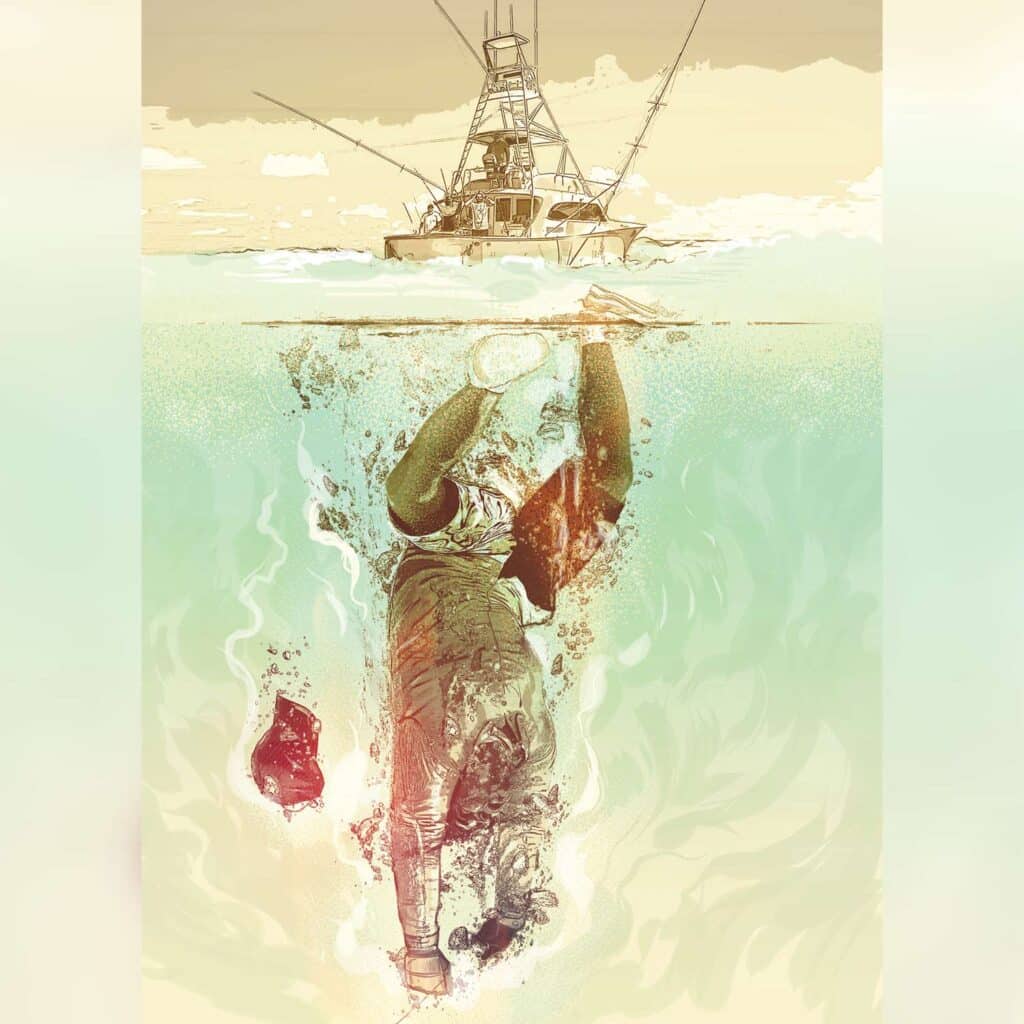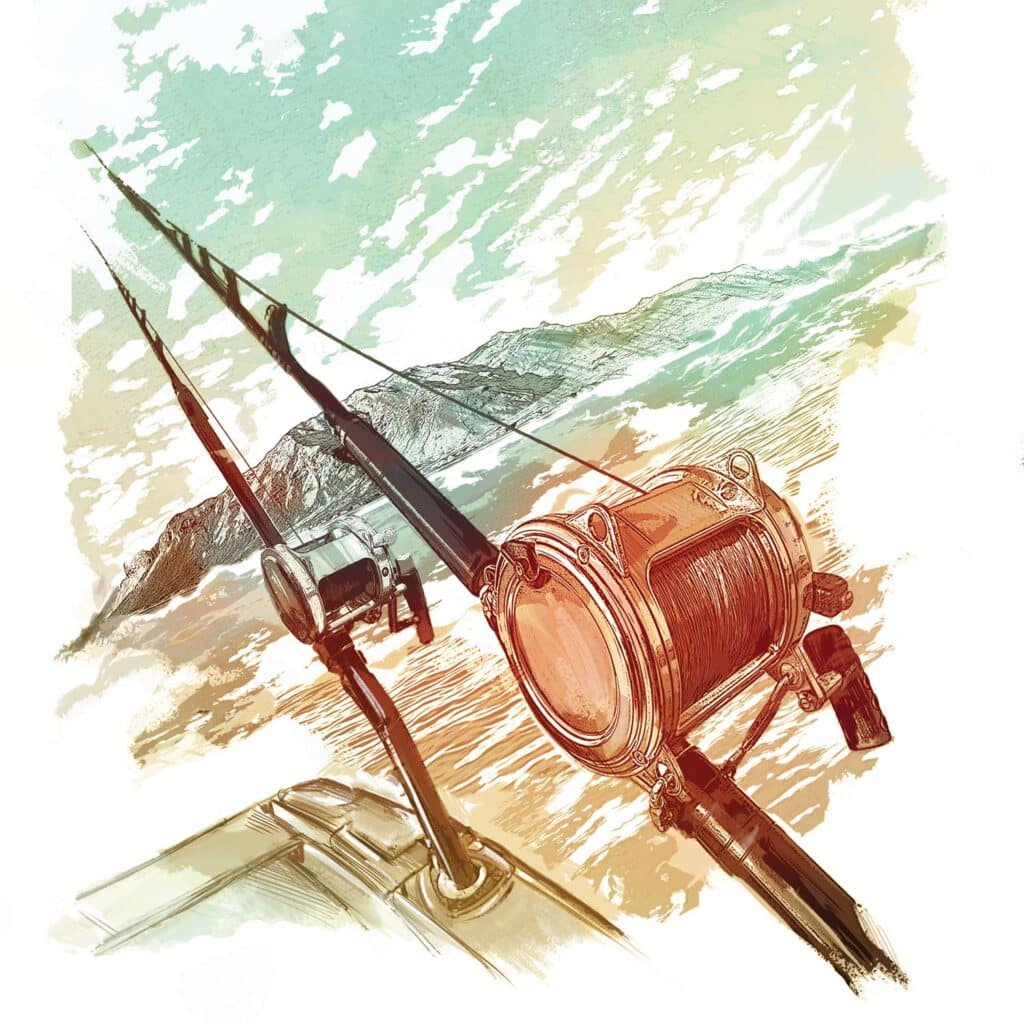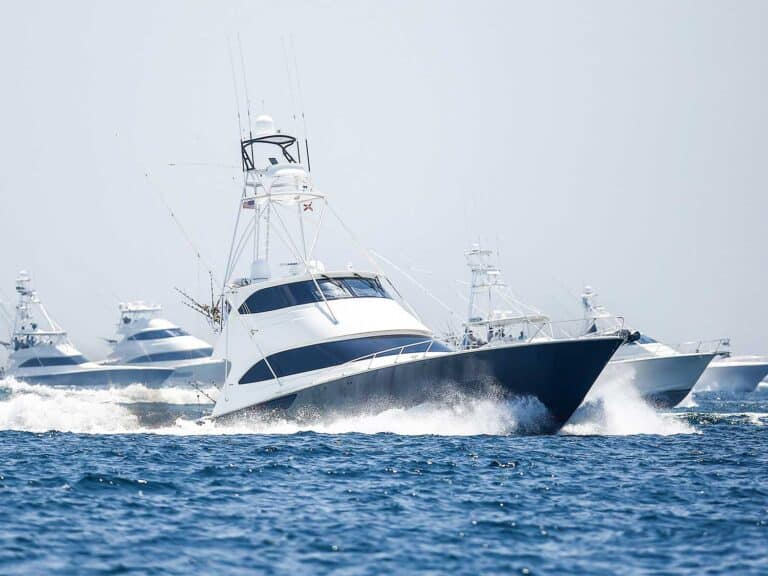
Special delivery: Sign up for the free Marlin email newsletter. Subscribe to Marlin magazine and get a year of highly collectible, keepsake editions – plus access to the digital edition and archives.
Summer 1992: The warm blue water of the Virgin Islands’ North Drop filled my sinuses as a sickening feeling of weightlessness overcame me. With two bad wraps of 600-pound Jinkai monofilament around my right hand, I was being pulled into the abyss. Dread and panic followed as I struggled to reach for my mono cutters on my right side with my left hand, my eardrums swelling from the pressure as I watched the light fade. With only half a breath and the surface seemingly miles away, I’m not going to make it was my only thought.
Suddenly, I felt the pressure release from my hand, and in disbelief, I quickly unwrapped the cinched leader from my glove and headed toward the surface. My lungs were burning. Just when I thought I was in the clear, I was engulfed by a wave of white bubbles—the force of a 60-foot Hatteras’ prop wash at full throttle hit me like a freight train—catapulting me into a spinning ball, my head between my legs as I was somersaulted through the water column before it pushed me to the surface. Soon, I found myself gasping for air; shock had already set in. As I focused on the boat that seemed miles away, I could hear the crew screaming, “Swim!” and waving me toward them. I took one long stroke and glanced to my right—20 feet away was a green 300-pound blue marlin shaking its head on the surface and heading in the same direction.
I had looked into the eyes of 12 blue marlin before this one, but seeing No. 13 in its element was etched into my memory forever. I quickly swam back to the boat, and the crew of captains snatched me through the transom door. Capt. Earl Keen yelled from the bridge, “Grab that leader, Tiny!” I was shaken to my core and reached for the swivel again, quickly took a wrap, and cut the leader free. Then a shower of criticism rained down on me from upstairs because I had just cut off his favorite lure in fearful haste.
Minutes earlier, we were having a fun “crew day” trolling around Dick Love’s Sound Machine. Just as Capt. Skip Smith pinwheeled the 48-foot G&S to seal the deal on the men’s 8-pound world-record 330-pound Atlantic blue marlin, the right short snapped from the clip, and we were on. Ironically, Sound Machine’s guest gaff man, Perry Osmond, also went overboard. Two crewmembers on two separate boats, side by side, were simultaneously in the water on the North Drop. Both of us were lucky that we didn’t drown or get run over by the boat, thanks to the quick thinking and experienced boathandling by the captains. And to this day, I am thankful to Capt. Rusty Watters for his acute awareness to put the reel in free-spool and give me the opportunity to escape a grim, watery grave.
From Fault Comes Fortune
The fish that pulled me in was not by any means big by blue marlin standards, but it was very green. I grabbed the leader within a minute of getting the lines cleared, only to have a single bad wrap torn from my glove. Seconds later, I grabbed the 30 feet of slack leader as the fish went airborne under the portside outrigger. The crucial mistake: I was holding on and flipped the fish over. I was determined not to let go, and with a full head of steam, the fish blazed past the transom as the leader came tight. I was standing up straight and was not in position or prepared for this. If I wasn’t completely off balance, I could have easily dumped the wraps, but instead, I was snatched off my feet into midair, never even touching the gunwale—purely a rookie mistake that could have cost me my life.

Before hitting the dock, the panel of captains on our boat had nicknamed me “Splash,” and the celebration of Sound Machine’s record catch raged on into the wee hours of the morning. Thankfully, my near-death experience was quickly forgotten. I woke up early the next day and proceeded to quietly work on tackle in the cockpit of Penny Reel, only to hear the raspy voice of Capt. Ronnie Hamlin say, “I heard you got lucky yesterday.” I sheepishly replied, “Yes, sir.” Hamlin requested a length of leader, wiring gloves and a bucket. Sitting on a picnic bench in Red Hook, he patiently taught me how to take proper wraps and the intricacies of wiring technique that he had perfected over many years. Most important, he taught me how and when to let go of a hot fish. I wired that full 5-gallon bucket dozens of times under the scrutiny of Capt. “Hook,” and to this day, I’m grateful for that lesson.
I was 19 years old and roughly 250 pounds when I got pulled in. This experience taught me that size does not matter when wiring fish, but intelligence does. And being big is actually a hindrance. After the humbling “Splash” experience, I studied many hours of videotape from some of the world’s top crews, which helped me to form my own style of wiring fish that constantly evolved once I had the basics and advanced techniques down, and I always asked the captains I worked with for an honest critique. Knowing what I needed to improve on from the guy upstairs was a very important part of learning good wiring skills—the captain always had more experience, as well as a better view of the mistakes I made. Always. But being aware of what could (and did) happen didn’t keep my knees from knocking or my hands from shaking each time that swivel broke the surface.
A few days after my fateful swim, the next fish I wired was a 600-pound blue that was foul-hooked in the middle of the back and insisted on paddling down-sea for a mile. I was alone in the cockpit, the leader was 30 feet of No. 19 wire, and if I made a mistake with this fish, it was going to be serious. I practiced letting go at least a dozen times with Keen cheering me on as he kept the throttles pinned in reverse.
As Hamlin’s words echoed in my head, the beast finally rolled over—and to my delight, the hook pulled out. Completely exhausted and out of breath, I knew right then that I was never going swimming again. There is no doubt that had I not been pulled in days earlier, bad things could have—and would have—happened to me with this fish. It was a great reward for getting back on the horse, and although it was terrifying, a lesson was learned: The loss of leverage and the ability to pull my hand back to my body was impossible while being pulled down by the fish. The tightly stretched and improper wraps of monofilament around my glove had formed a half hitch, and the loss of leverage due to no footing was causing serious panic. Only after Watters backed off the drag was I able to free myself from that extremely angry blue marlin.
Beware of the Small(ish) Ones
As my travel and experience grew, I learned that many of the best in the world were members of the infamous Underwater Wireman’s Club. Elite crewmembers such as Capts. Randy Baker, Scott Levin, Scott Mantz, Charles Perry and Randy Yates have all been pulled in, some numerous times. Perhaps it is bound to happen when dealing with thousands of billfish, but it’s still an experience worthy of remembering.
On two different occasions, Baker was pulled overboard by a small blue marlin. But because of his astute situational awareness, he allowed both fish to pull him safely away from the boat on the surface. Levin also experienced going overboard twice attached to a blue marlin. Years of light-tackle, world-record wiring experience resulted in Levin almost getting run over when Sound Machine roared backward at 17 knots. He somehow came back without injury, his shirt covered in bottom paint. A close call, to say the least, but the second time, a failed gaff attempt caused the fish to jump away, and as Levin was dumping the leader, a loose coil of the 27-foot 600-pound leader half-hitched his middle finger and he went overboard, causing a serious laceration resulting in several stitches. Luckily, he was able to get back in the boat and ultimately wire the tournament-winning fish, blood and all.
Yates suffered a severe propeller laceration to his calf muscle after being pulled in off the coast of Venezuela by a juvenile blue marlin. The boat was in neutral, but the prop was still turning. Good boathandling skills and quick reflexes by the captain averted a more serious injury—another crazy small blue marlin was the culprit.
The first time Baker went in, he was attached to a 400-pound Pacific blue while fishing on The Hooker with 50-pound-test tackle in the Cocos Islands off Costa Rica in 1994. He got one wrap of the 28-foot leader before the fish pulled him to the covering board. He heard the line behind him snap as the tip-wrap came tight. Baker decided to hang on, anticipating that the blue would jump straight off the stern, but the fish decided to do a 180 and jump forward, under the port outrigger.

While Capt. Trevor Cockle was spinning hard and following the fish’s every move, the boat rolled to port, and Baker got launched horizontally, flying over the covering board. Instinctively, he held on to the leader to allow the fish to pull him away from the boat. The midrange blue finally stopped, and still holding the leader, Baker somehow got his head out of water, only to hear the engines still revving and mate Curt Schloderer yelling, “Neutral!” The boat coasted to a stop and mildly hit Baker as he curled up and pushed himself off the hull, grabbing his lone floating flip-flop and ball cap as the crew pulled him—relatively unscathed—through the transom door.
The second time he went swimming, a psychotic little Atlantic blue marlin decided have his way with Baker off the coast of Cape Verde. It was 1998, and The Hooker team had just started using circle hooks. Standing in the right corner, Baker managed to get his textbook wraps on this 250-pounder just before the fish shot across the transom. Trying to beat it to other side, the leader came tight before he was sure-footed and ready, pulling him off balance, and then bouncing him off the covering board and into the water. Not wanting to relive the first experience, he dumped the leader; Cockle put the boat in neutral, and Baker got back into the boat and wired it again.
The strangest part of these two stories? Baker says that he would do the same thing again on both fish simply because he wasn’t in trouble with bad wraps. “I was told early on in my career that if you ever get pulled over, hold on to the leader so that the fish pulls you away from the boat, which is still in fish-chasing mode,” Baker says.
Baker also insists that you absolutely have to keep your wits about you, wear the correct tools that could possibly save your life, and stay calm in either situation—if you want to have any shot at feeling the deck under your feet again. After hitting the water in complete surprise, all he could think about was, Where is the boat and am I going to get run over? Luckily, both times he went over the side instead of straight off the back. Another piece of solid advice: If you’re gonna be dumb, you’d better be tough.
Know Your Adversary
The subject of proper wiring techniques has been covered many times in many publications, including this one [“The Anatomy of a Wireman,” June/July 2020], but it’s just as important to cautiously learn from experience and remember what you’re dealing with. Although some of the best crewmen around have had some crazy experiences, I can promise you 100 percent that they have learned something from every billfish encounter. They know these fish well but always take into consideration that they are dealing with wild animals. And while behavior on the leader takes many forms, there is always going to be that one fish that does something that no one has ever seen before.
Marlin will give you a sign that they are particularly displeased with the way they are being treated on the wire. Besides being generally unhappy with the situation, they will, most times, give you a clue when they are about to make their next move, especially while on the surface. An abrupt change of color, flaring gills, or even moving their dorsal fins up and down rapidly should be a clear sign to you, or at least one you should take note of.
Read Next: Get to know Charles Perry, one of the finest wiremen in the game, in our exclusive interview.
There are some scenarios in which a fish could be particularly unpredictable as well. Marlin that are hooked in the eyeball, foul-hooked in the top of the head or in the dorsal fin tend to come at the boat very quickly and be extremely erratic boatside. Be ready to handle these fish with caution, and keep yourself aware of your surroundings. And never tag a green fish while he’s down deep, or if the wireman is transitioning from one side to the next, because this can cause the fish to react with an unexpected burst of speed and power. Tag a fish only when it is completely under control: when the fish’s head is elevated and just under the surface so that the tag can be placed safely in the shoulder.
You also should always be prepared to let go of the leader, especially once you evaluate how green the fish is or how long the fish has been engaged. It takes infinitely more skill to know when to let go than it does to hold on, and this is learned only by experience. A good wireman will know what his level of ability is, and captains will recognize that. If things are about to change, and not necessarily in his favor, he must know when to let go. Plus, there is a bonus in letting the leader go: You get to grab it again.
Just because you go swimming with your blue marlin doesn’t mean you’ve failed, especially if you can tell the tale. Proper technique, sobriety, and level-headed thinking will keep you in the game for a long time. Professionals have a ton of insight on what to do if you hit the water while attached to a fish, how to avoid it, and how much every experience means in the grand scheme of things. So, take it from some old pros, and remember: Practice (always) makes perfect, no matter how many fish you’ve had on the wire.







